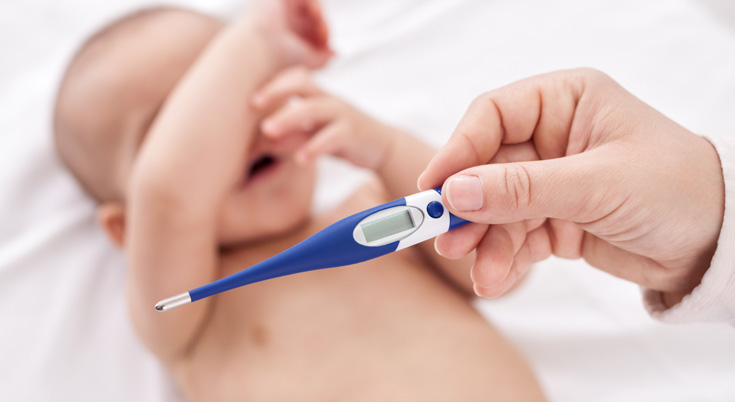As parents, you definitely try your best to provide care and warmth to your baby. But sometimes, despite best efforts, your baby’s temperature may drop below the normal levels. Well, you may be aware that higher body temperature is suggestive of fever; however, many parents do not know that lower body temperature in babies is also indicative of some underlying medical condition.
Read More:11 Ways You Can Soothe Your Child During Fever
In this article:
What happens if Your Baby has a Low Body Temperature?
What are the Causes of Low Temperature in Babies?
What are the Symptoms of Low Temperature in Babies?
How to Deal with Low Body Temperature in Infants?
When Should I take My Child and Visit a Doctor?
Low Body Temperature in Babies: Every Parent Should Know
What happens if Your Baby has a Low Body Temperature?
The normal body temperature of a baby usually lies between 36 to 37 degrees Celsius, which may vary slightly. Any other changes in the temperature range may result in a fever or hypothermia. The temperature of the bodies of children varies due to their activity levels, nutrient consumption and various other causes. Your baby might be suffering from fever if the body temperature goes above 37.5 degree Celsius or 99.5 degrees F. And if the body temperature dips below 35 degrees C, then this causes a sickness known as Hypothermia.
Newborn babies are more prone to developing hypothermia.
Read More:11 Home Remedies to Manage Fever Due to Exertion in Children
What are the Causes of Low Temperature in Babies?
To maintain a normal temperature, several systems of the body have to work together and therefore, low body temperature can be connected to many factors such as:
Cold Environment
If the surroundings are cold or the temperature is low then it may result in hypothermia and excessive air conditioning is also harmful to the infant.
Infections
If your child has a bad immune system, then they may develop the condition due to infections or it may also be a side effect of medications.
Deficiencies
Nutritional insufficiencies can also lower the temperature of the body. It is a common thing to observe that the body of the child feels cold to touch when they’re hungry.
Low Birth Weight Babies and Premature Babies
Babies who have 1.5 kilograms or lesser birth weight and babies who are born at 28 weeks or earlier than that are at a greater risk of hypothermia, soon after they are born. Your baby may be put in the neonatal care unit for a few weeks or till his body is strong enough to support itself.
Neurological Issues
Toddlers suffering from neurological issues may also experience low body temperatures and can suffer from hypothermia.
Other causes may include:
- Abnormal oxygen or food supply
- Abnormalities in the functioning of thyroid glands which regulate the metabolic activity
- Anaemia, an iron deficiency may also lower the body temperature
- Any diseases that are related to the immune system are also responsible for lowering the body temperature
What are the Symptoms of Low Temperature in Babies?
Your baby’s symptoms may vary as per the type of hypothermia your baby has. Following are some of the symptoms of mild, moderate and severe hypothermia:
Symptoms of mild hypothermia include the following
- Your baby may be cold to touch.
- Your baby may have lower energy levels.
- Your baby’s skin may appear discoloured or reddish.
- Your baby may feed poorly.
- Your baby may feel dizzy and may shiver too.
- Your baby may develop hypoxia.
Symptoms of moderate hypothermia include the following
- Your baby may experience difficulty in moving.
- Your baby may experience excessive and uncontrolled shivering.
- Your baby may find it difficult to babble or make sounds.
Symptoms of severe hypothermia include the following
- Your baby’s pupils may dilate
- Your baby may fall unconscious
- Your baby’s activity may decrease considerably
- Your baby’s heartbeat may be below 60
- Your baby may experience weight loss
- Your baby’s pulse may become weak and difficult to detect
- Your baby’s ECG reading may be abnormal
How to Deal with Low Body Temperature in Infants?
There are several measures you can take at home to help ease your baby. You can deal with your baby’s low body temperatures through the following methods:
Room Temperature
Room temperatures may be the cause of your baby’s low body temperature. Though babies can regulate their body temperatures, it is not as effective as adults can. Accordingly, it is important that you maintain comfortable room temperatures in both winter and summer months.
Read More:7 Ways You Are Slowing Your Child’s Development (4th will shock you)
Warm Bath Water
Newborn babies usually do not require a tub bath and fine with sponge baths with warm water. However, if you wish to bathe your baby, it is suggested that bath water should neither be too cold or hot. Make sure you check the water before you start bathing your baby. Do not let your baby spend too much time in the water and wrap your baby immediately after bathing and keep them dry.
Swaddle the Baby and Provide Warmth
Many parents swear by swaddling to keep their babies warm and comforted as it mimics the feeling of being in the mother’s womb. It is a great way of keeping your baby warm in summer when the AC is on and also in winters when the temperatures are low outside. Use hot packs, chemical heating pads on the chest, neck, back and other areas of the body is recommended. However, make sure you do not keep your baby swaddled up beyond 4 to 5 months of age. If your baby is more than 6 months old, give them a warm drink.
Skin to Skin Contact
Most hospitals would keep the baby on the mother’s chest soon after birth as it helps in building the mother-baby bond. However, it is also a great way of providing warmth and care to your preterm baby. The Kangaroo care method is a way of giving close body contact and heat to your premature baby and can help in regulating the baby’s temperature.
Keep Monitoring Your Baby’s Temperature
It is suggested that you keep monitoring your baby’s temperature on a regular basis. This way you will be able to register any change in your baby’s temperature and you can take immediate action. A digital thermometer is a good option for maintaining your baby’s temperature. You may measure your baby’s temperature before and after taking a bath or when you expose your baby to an air-conditioned environment.
When Should I take My Child and Visit a Doctor?
A low body temperature is not good for your baby; however, if your baby’s temperature drops below 32 degrees, this could mean severe hypothermia and requires immediate medical attention. As soon as you register such low temperature in your baby, you should get in touch with your doctor, and your baby will be given emergency care. This may cause life-threatening complications, organ failure and other fatal difficulties in babies.
No matter whether you register baby temperature low at night or anytime during the day, you must seek medical help. This is because sometimes the temperature measured from the armpit may not be accurate and rectal temperature may need to be taken, which is best done under medical supervision at a hospital.
Though sometimes certain preventive measures may work, however, it is suggested that when it comes to babies, always seek your doctor’s advice. Timely medical intervention may save your baby from various life-threatening conditions.
Sources
https://www.healthline.com/health/parenting/baby-temperature-low
https://www.mayoclinic.org/diseases-conditions/hypothermia/symptoms-causes/syc-20352682













